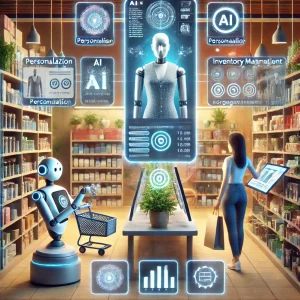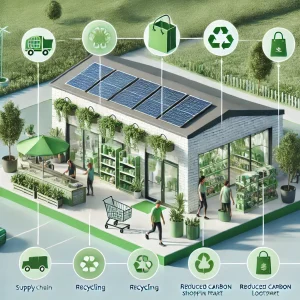Future Trends in E-Commerce and New Retail 2024
In a rapidly changing business environment, e-commerce and new retail are facing unprecedented opportunities and challenges. In this article, we look at three of the most important trends for 2024: virtual and real retail integration, AI-enabled retail, and sustainable and environmentally friendly development of the retail industry. Let's take a closer look at how these trends will shape the future of retail.
Trend 1: Virtual and Real Retail Integration
Question
Traditional retailers are facing enormous pressure from online competition, while pure e-commerce brands are also realising the importance of their physical presence. Striking a balance between these two areas has become a major challenge for the retail industry.
intensify
According to McKinsey, e-commerce retail business will account for half of global retail revenue by 2025. This means that companies that do not adapt to this trend could lose significant market share. Meanwhile, research shows that 60% of Gen Z consumers still prefer to shop in physical shops, highlighting the continued importance of the offline experience.
Solutions
Physical layout of online brands
- Case Study:PAZZO's Successful Transformation
- Of those who spend in physical locations, 72% return within 30 days to spend online, much higher than the monthly return rate of 24% for the average online member.
Implementation Strategy:
- Choose the right location, giving priority to shopping districts with a high concentration of young consumers.
- Design a unique in-store experience that combines online features with offline interaction.
- Use the data collected in the physical shop to optimise your online operations.
Digital Transformation of Physical Retail
- Data-driven:Use AI and big data to analyse customer behaviour and provide personalised services.
- Technology applications:Introducing AR/VR technology to enrich the in-store experience.
- Seamless payment:Promote mobile payment and self-checkout systems to improve efficiency.
Omni-Channel Sales Strategy
- Integrated inventory system: real-time synchronisation of online and offline inventory.
- Flexible Delivery Options: We offer a wide range of options such as pick-up at the shop, same-city delivery, and more.
- Unified Membership System: Connect the online and offline membership system to provide consistent benefits and experience.
Action Suggestions
Evaluate your existing sales channels and think about how to better integrate online and offline resources. Start with a small-scale pilot, such as a pop-up store or shop-in-shop, and gradually expand your physical presence.
Trend 2: AI Enables Retail Sales and Operations

Question
Retailers are faced with the challenges of massive amounts of data, complex supply chain management and ever-changing consumer demands, which are difficult to cope with with traditional operational methods.
intensify
According to a Statista report, the global AI in retail market reached $23.1 billion in 2023 and is expected to grow to $59.5 billion by 2027. Retailers that don't adopt AI technology may fall behind their competitors in terms of efficiency and personalised service.
Solutions
Personalised Recommendations and Purchase Suggestions
- Case in point:Amazon's recommendation system has increased sales of 35%.
- Implementation:
- Collect and analyse user browsing and purchasing data.
- Use machine learning algorithms to predict user preferences.
- Present personalised recommendations on websites, apps and email marketing.
Demand forecasting and inventory management
- Technological applications:Forecasting demand using time series analysis and machine learning models.
- Effect:Walmart applies AI for demand forecasting, reducing inventory costs by 10-15%.
Dynamic Pricing
- Principle:Prices are adjusted in real time according to market demand and competition.
- Case in point:U.S. supermarket chain Target uses AI for dynamic pricing to boost gross margins by 2-5%.
Intelligent Customer Service
- Apply:24/7 customer service using natural language processing technology.
- Effect:After introducing AI customer service, a major retailer saw a 20% increase in customer satisfaction and a 40% reduction in labour costs.
Action Suggestions
Start with a specific pain point, such as inventory management or customer service, and choose the right AI solution to pilot. Work with technology vendors to ensure the solution integrates seamlessly with existing systems.
Trend 3: Eco-friendliness and sustainability in the retail industry

Question
Consumers are becoming more aware of environmental protection and sustainability, and the traditional retail model is facing criticism for resource wastage and environmental pollution.
intensify
According to a Nielsen survey, 73% millennials are willing to pay higher prices for sustainable brands. Brands that don't take the environment seriously may lose out on this important segment of consumers.
Solutions
Green Supply Chain
- Case in point:H&M Group is committed to achieving 100% of recycled or sustainably sourced materials by 2030.
- Implementation:
- Audit suppliers' environmental practices.
- Invest in renewable energy and energy-saving technologies.
- Optimising logistics routes to reduce carbon emissions.
Reducing the use of plastics
- Data:Unpackaged shop Lush reports that its solid shampoo has helped reduce the use of 6 million plastic bottles.
- Strategy:
- Promote reusable shopping bags.
- Biodegradable packaging materials are used.
- Set up a packaging recycling programme.
Secondary Market and Circular Economy
- Trend:The used clothing market is expected to reach $77 billion by 2026, according to a ThredUp report.
- Action:
- Establishment of a product take-back system.
- Launched a trading platform for second-hand goods.
- Provides product repair and refurbishment services.
Education and transparency
- Strategy:Educate consumers on the importance of sustainable consumption through product labelling and marketing campaigns.
- Case in point:Patagonia's "Worn Wear" programme not only extends the life of its products, but also fosters environmental awareness among its customers.
Action Suggestions
Review your supply chain and product lines to identify areas for improvement. Consider launching an eco-friendly product line or implementing a recycling programme, and communicate these efforts transparently to consumers.
Conclusion
Retail in 2024 is facing unprecedented changes. Virtual-reality integration, AI adoption and sustainability are not just trends, they are essential for survival and growth. Retailers need to be flexible and innovative to remain competitive in this rapidly changing market.

